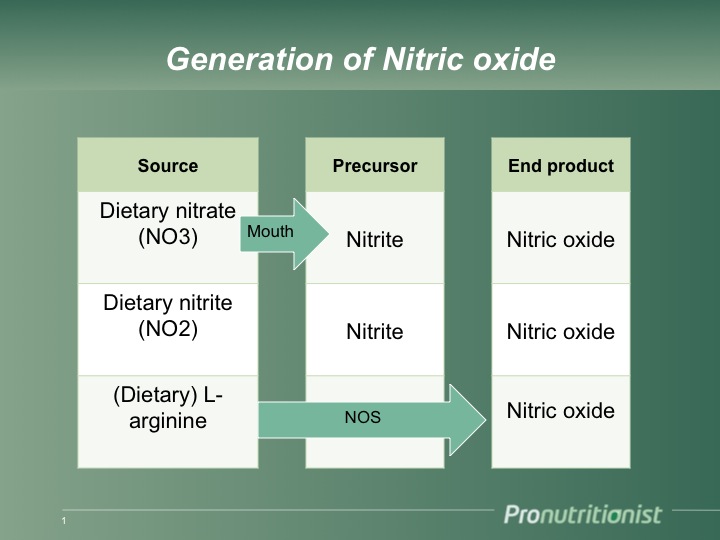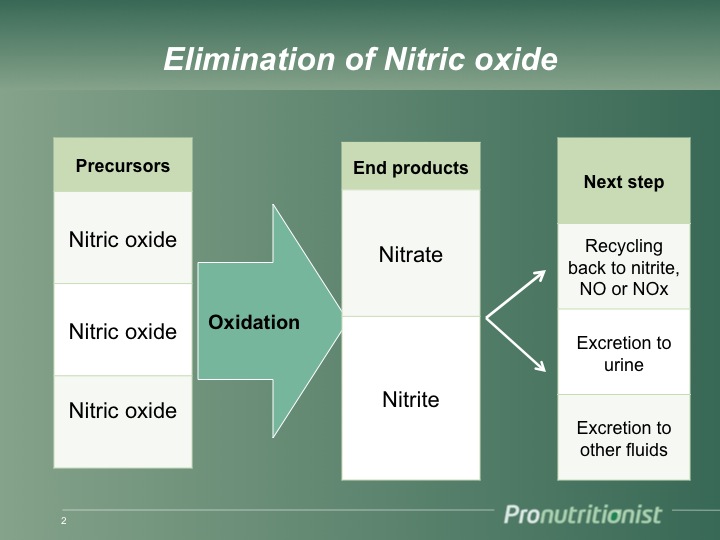Picture credit: Norberto Mario Lauría Dreamstime
Just before the summer holidays, I came across a scientific study on nitrates. The study from Queen Mary University of London revealed that nitrates might be major players in blood pressure regulation (Kapil V et al., 2010). Researchers ran three different sorts of randomized trials and could show that systolic blood pressure decreases by some 5 mm Hg when either nitrate supplement or root beet juice was consumed. As generally known, root beet is rich in nitrates. Researchers could also show that the control substance, KCl including equal amount of potassium, did not affect blood pressure. These data are remarkable, especially because the participants of the study were normotensive.
These data are not the only ones to support the benefits of nitrates. Webb et al. (2009) and Sobko et al. (2010) also reported similar results. Furthermore, two other studies pointed out that dietary nitrates may enhance physical capacity in sub-maximal exercise (Bailey S et al., 2009 and Larsen et al., 2007).
Dietary sources of nitrates and nitrites
Nitrates (NO3) are rapidly converted into nitrites (NO2) within the body (by bacteria in the mouth and gut) and are naturally found in vegetables. There is a consensus that dietary nitrates are essentially inert and acquire biological activity only after reduction to nitrite.
Vegetables such as spinach, root beet, rockets and carrots are rich in nitrates, likewise most root vegetables. Vegetables grown in hothouses can include 5-10 times more nitrates than those grown in the field. Organic vegetables contain obviously less nitrates as they are grown without fertilizers.
Meat is a modest source of nitrates and nitrites. Nitrates are used as fertilizers and preservatives or color enhancing agents in processed meat. Nitrites also function as preservatives and colorants in the meat industry. The meat industry normally adds nitrates or nitrites as sodium nitrate/nitrite (NaNO3/NaNO2). However, on an average consuming processed meat results in around 5-20% of nitrate intake, drinking water around 10-25 % and the overwhelming majority comes from vegetarian food (Hord et al., 2009).
Nitrate is one of those nutrients where the largest interpersonal variations are observed. In a cross-sectional study among pregnant women, the intake varied from 2.5 mg to 800 mg per day, whereas the mean was 40 mg (Griesenbeck et al. 2010). Then, imagine if we had such a variation in salt intake! In the cited study, nitrite intake was only about 2% of nitrate intake. The intake of nitrite is usually much (over 90%) lower than the intake of nitrate. One important concept is the total nitrite intake, which is calculated to give an idea about the total exposure to nitrites. Total nitrite intake is calculated by adding 5% of nitrate intake (NO3) to nitrite (NO2) intake.
Nitrates as medicine
Nitrates in medicines help in treating angina pectoris. Nitroglycerine, a relative to nitrate, has a long tradition in the treatment of angina and is still used in constituent therapies for coronary artery disease (CAD). It also lowers blood pressure. Animal studies have shown that dietary nitrates also dilate coronary arteries and protect them from ischemia and large infarction (Bryan et al., 2007). There are no human studies on the dietary nitrate’s capacity to prevent ischemia and infarction size so far.
Endogenous nitrites
Some of the body’s nitrites are also formed endogenously from nitric oxide by some cells (Nitrate and Nitrite in Drinking Water, The National Academies, Tota B et al., 2010). In humans, this is estimated to represent up to 70% of the total body’s circulating nitrite pool. If most of the body’s pool is formed endogenously, how much should we worry about negligible sources of nitrites or nitrates such as processed meat?
Circulating nitrites give a prompt to arterial dilatation (via NO)
The whole story of nitrites and nitrates becomes interesting with the notion that circulating nitrites are the largest reservoir for nitric oxide (NO) in the body (Tota B et al., 2010). Nitric oxide is a gas that is responsible for blood circulation. It dilates arteries and prevents coagulation and calcification of arteries. Some say that NO is nature’s own nitroglycerine. The inner lining of arteries, called endothelium, produces NO from the nitrite reservoir. This remarkable finding led to a nobel price in 1998. The production of up to 70% of systemic nitric oxide is accomplished by endothelial nitric oxide synthase (eNOS) in the vascular endothelium. An important indirect precursor of NO is amino acid arginine which actually increases plasma nitrate and nitrite and thus enables NO production. Another amino acid, citrulline (found in watermelon), is converted into arginine and lead to NO production as well. Citrullinen seem to be more potent than arginine per os. Polyphenols are also known to augment NO production (Stoclet J et al., 2004).
The diagrams below depict the generation and elimination of NO (adapted from Hord et al., 2009).
Atherosclerosis and its risk markers such as dyslipidemia and hypertension decrease the capacity of the endothelium to produce NO. It would be interesting to find out more if dietary nitrates can also increase the endothelial production of NO in patients with CAD and ultimately relieve the symptoms. Unfortunately, there are no clinical studies on this so far.
Even more intriguing is the question as to whether NO’s precursors in the diet, nitrates and nitrites, are one major reason why vegetarian food seems to be protective against cardiovascular diseases. This question was raised by Hord et al. (2009), in the American Journal of Clinical Nutrition (AJCN). The researchers speculated that the dietary approaches to stop hypertension (DASH) diet, which has benefits at least in high blood pressure, can contain up to five times more nitrates than recommended by WHO, and can be the unacknowledged reason for observed health effects of DASH diet (Hord et al., 2009)
Risks associated with nitrates
Cancer
High intake of nitrates and nitrites is carcinogenic in animal models. In humans, the association between cancer and nitrites is uncertain. Some studies have observed a link, especially with animal-based nitrates, whereas others have not.
Nitrates and nitrites themselves are not carcinogenic, but nitrites formed from dietary nitrates might react with dietary amines to form carcinogenic nitrosamines (like N-nitrosodmethylamine, NDMA), especially when meat-containing nitrites or nitrates are cooked or grilled. Martin Katan stated in his editorial in AJCN (2009), “Thus, evidence for adverse effects of dietary nitrate and nitrite is weak, and intakes above the legal limit might well be harmless.”
Infant methemoglobinemia
The body’s nitrites can react with hemoglobin to produce methemoglobin, which no longer has the capability to carry oxygen. There is evidence that infants may consume as much as 100 mg nitrate per kg without developing methemoglobinemia. One observed epidemic among infants in the US during the late 1940s is now known to have its origin in fecal contamination of drinking water rather than natural high nitrate content of water in the affected district (Katan M, 2009).
Other risks
There is lack of knowledge around other risks. Nitrates have been associated with elevated risks of neural tube effects among women when they are co-consumed with N-nitroso-medications (Brender JD et al., 2004).
If nitrates really are dangerous, we might all start using a mouthwash one day. A study has shown that when mouth bacteria are eliminated by antibacterial mouthwash, nitrate exposure is markedly decreased (Govoni et al., 2008). On the same token, we might lose all the potential cardiovascular benefits as well.
Authorities have problems in deeming risk-benefit ratio of nitrates
In the European Union, the European Food Safety Authority (EFSA) has concluded that health benefits of nitrates outweigh the possible risks. EFSA also stated in the same report that “high level consumers of vegetables grown under unfavorable local production conditions may exceed the ADI[n2] approximately two fold.“ It continued that 48 g of rucola (rockets) can cause override of ADI without, taking other sources of nitrates into account.
In Finland, local food authority Evira has started an evaluation on the intake and safety of nitrates in the Finnish population. The report should be out in 2011. The acceptable daily intake for humans is 5 mg sodium nitrate or 3.7 mg nitrate per kg body weight, which equals c. 300 mg for a 80-kg adult (WHO).
How to estimate nitrate and nitrite intake
The estimation of daily nitrite exposure is not easy. Commonly used databases such as Nutritiondata or Fineli in Finland do not provide data. As stated earlier, the circumstances of where and how vegetables are grown affect nitrate content in vegetables. Hothouse conditions and use of fertilizers produce more nitrates in food.
US researchers have composed food frequency questionnaires for research purposes (Griesenbeck J et al., 2009). The same open paper also includes a readable table on the nitrite/nitrate contents of food items. This table (#2)[n3] can be useful for professionals and individuals who seek to estimate their dietary nitrate intake.
Dietary nitrate will be focal point
Martin Katan stated in his editorial in AJCN 2009 that “A trial to investigate whether nitrate in vegetables is healthy is thus feasible. … Such a trial urgently needs to be conducted”. It is of interest that dietary nitrates may also protect from NSAID induced gastric ulcers (Jansson et al., 2007). Others have also shown protective effects of nitrates on gastric mucosa.
Dietary nitrates and nitrites are going be talk of the town in the near future. Presently, as the interest has arisen, we will surely hear soon about cross-sectional data on how nitrate intake is associated with coronary risk. A couple of years down the line, we will also hear about randomized human trials. Pronutritionists will definitely stay tuned on the subject.
Key points:
1. Nitrates occur mainly in
- Vegetables and fruits (>80% of intake)
- Drinking water (<10% of intake)
- Processed meat (<10% of intake)
2. Nitrites occur mainly in
- Processed meat
- Vegetables and fruits
3. Nitrates are rapidly reduced into nitrites in the body.
4. Nitrites are formed substantially from endogenous sources (nitric oxide)
5. Total nitrite intake is calculated by adding 5% of nitrate intake (NO3) to nitrite (NO2) intake.
6. Exposure to total nitrite varies enormously between individuals by the type of food consumed
7. Nitrites give rise to NO production along with L-arginine, citrulline and polyphenols
8. Increased NO production may explain the observed positive effects of nitrates on cardiovascular system
9. Long-lived suspicion that intake of nitrates is link to cancer incidence is not fully substantiated, nor invalidated
10. Potential health effects of nitrates need to be evaluated in large-scale clinical trials

